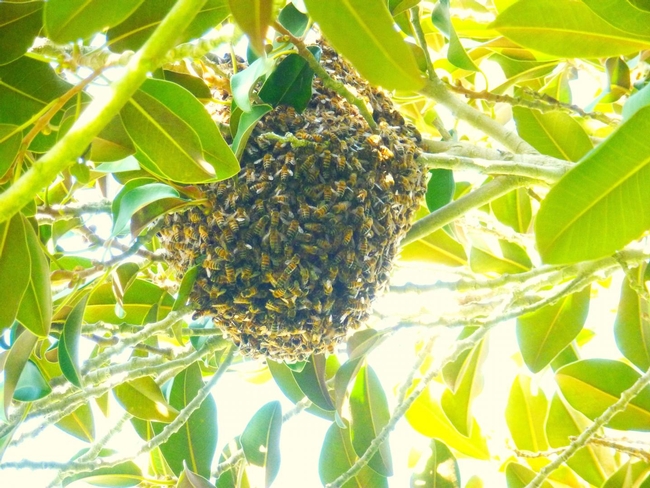Species that move into new areas are known as adventive, but the word has several shades of meaning. Some scientists include deliberately introduced species, but others include only those that arrived on their own or by accident.
Some writers use adventive to describe species that are not self-sustaining, but need an occasional population boost from their homeland. If an adventive species becomes self-sustaining in its new geographic area, it is then said to be naturalized. Other words with variable meanings such as acclimatized, immigrant, and invasive make the subject even more confusing. One of the impacts of climate change is the movement of organisms, following favorable environments, and naturalizing in a new location that has the environment it needs to thrive.
Rusty Burlew of HoneyBeeSuite raises this issue of what to call organisms that arrive in a new home like California and how to classify them – “Are Stingless bees moving north?”.
While humans were busy squabbling over the border between the United States and Mexico, a tiny black immigrant bee was discreetly homesteading in California. A new sighting of a Central American native bee, a member of the genus Plebeia, was recently reported in a genteel area of Palo Alto, some 500 miles to the north of Mexico.
Apparently, the manager of the Elizabeth Gamble Garden, an iconic public park, contacted a company for help in removing a bee nest from the premises. On seeing the nest, however, the exterminator sent a specimen to an entomologist who recognized the bee as Plebeia. Plebeia is one of many genera belonging to the tribe Meliponini, commonly known as the stingless honey bees.
Until this sighting, only one stingless bee colony was known to exist north of the Mexican border, a nest that was first discovered in a Palo Alto backyard in 2013 and was being monitored by the State of California. Plebeia is a small genus of heat-loving bees native to southern Mexico and Central America that ranges as far south as Argentina. Since the first sighting in California, at least three other photos of Plebeia have shown up on the citizen science site iNaturalist.org, all within a short distance of the original nest. These recent sightings are most likely descendants of the 2013 colony.
No one knows where they crossed the border or how they got so far north. Someone could have smuggled them in, or perhaps they hitched a ride in a shipment of goods. It is also possible, though highly unlikely, they traveled on their own over the course of many years. In any case, higher than average annual temperatures no doubt played a role in their survival.
Photo: Plebeia, stingless honeybee. selwynq, https://www.inaturalist.org/photos/33865085
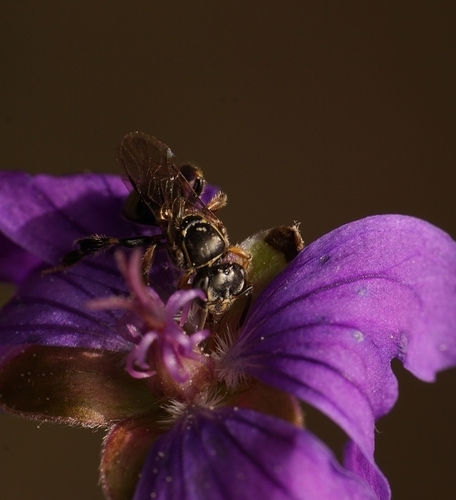
plebia selwynq
Posted on
Wednesday, November 6, 2019 at
5:49 AM
Foreign bees monopolize prize resources in
biodiversity hotspot
Immense numbers of introduced honey bees overwhelm native pollinators for access to pollen and nectar
University of California - San Diego
Hike around the natural habitats of San Diego County and it becomes abundantly clear that honey bees, foreign to the area, are everywhere. In a study published last year, researchers at the University of California San Diego found that honey bees are the most widespread and abundant pollinators of wild plants in the world, with the San Diego region having exceptionally high honey bee visitation on native plants--roughly three-quarters of all observed pollinators.
New research from the same team found that honey bees focus their foraging on the most abundantly flowering native plant species, where they often account for more than 90 percent of pollinators observed visiting flowers.
The new study by Keng-Lou James Hung, Jennifer Kingston, Adrienne Lee, David Holway and Joshua Kohn of UC San Diego's Division of Biological Sciences is published on Feb. 20 in Proceedings of the Royal Society B.
"To have a non-native species that removes the lion's share of pollen and nectar in a diverse ecosystem such as ours is stunning" said Kohn, a professor in the Section of Ecology, Behavior and Evolution. "Think about if we had an invasive plant that covered 75 percent of the region's land area--it's similar to that level."
The honey bees' monopoly over the most abundantly blooming plant species may strongly affect the ecology and evolution of species that are foundational to the stability of the region's plant-pollinator interactions, the researchers said.
"It's concerning enough that a non-native species reaches an overall 75 percent numerical dominance--what's more, we now show that their numerical dominance is even higher on the plant species that supply the largest amounts of pollen and nectar," said Hung, a former student of Holway and Kohn who is now a postdoctoral researcher at The Ohio State University. "This finding suggests that honey bees are disproportionately removing resources from the plant species that likely support the greatest diversity and abundance of native pollinator species."
From an ecological perspective, the new assessment could help habitat and wildlife management evaluate pollination services and native pollinator conservation in natural areas where non-native honey bees have become established.
"Our study is a first step in figuring out which plant and pollinator species may be most susceptible to interference from honey bees," said Hung. "This is also a great example of the importance of understanding the natural history of a non-native species when we attempt to evaluate its ecological impacts--both positive and negative."
Native to Europe, the Middle East and Africa, honey bees were introduced to North America in the 1600s. They spread in California after the state's gold rush in the mid-1800s. In San Diego, the great majority of honey bees foraging in natural systems are both feral and Africanized (an aggressive hybrid of the Western honey bee).
Behind the honey bees' ability to preferentially target the most rewarding plant species is the fact that they employ social communication to "spread the word" when flowers with rich pollen and nectar resources are available in abundance. Most pollinating insects native to the area are solitary, and thus not capable of such communication.
"Honey bees are thought to have the most sophisticated communication of all invertebrates. They can communicate the distance and direction of a high quality food source," said Kohn. "Native bumble bees are also social and are thought to communicate that there is a worthwhile floral resource and what it smells like, but they can't communicate distance and direction the way honey bees can."
Native bumble bees made up only 0.2 percent of insect visitors to flowers, perhaps due to competition with honey bees. These findings highlight the importance of considering the honey bee's unique foraging behavior when evaluating its ecological impact on native species.
San Diego County is considered a global biodiversity hotspot where researchers have documented more than 600 species of native bees, numerous other pollinating insect species and more plant species than any other county in the United States. According to the researchers, the high biodiversity, coupled with the fact that many plant and pollinator species in the region are threatened by habitat loss and climate change, means that any ecological impact of honey bees on native species could be especially consequential.
"There is little doubt that honey bees currently play an important role in pollinating native plants here in San Diego," said Hung, "but we need to also consider how honey bees may be impacting native pollinators by competing with them for limited food resources."
The researchers also point out that non-honey bee pollinators are known to increase the pollination success of many crop plants in California and elsewhere, even when honey bee hives are brought to fields by the truckload. So the maintenance of healthy populations of native insects is an important aspect of stable food production.
In addition to possible negative effects of honey bees on native pollinating insects, honey bees may negatively affect native plants as well. Studies in other systems have shown that too many visits by comparatively large and super-abundant pollinators such as honey bees can hinder plant reproduction because of damage caused to flowers. In addition, honey bees are known to visit more flowers on a plant before moving to the next plant than native pollinators. This may increase self-fertilization, which often leads to lower-quality seeds due to the negative effects of inbreeding.
The researchers are now investigating these and other possible ramifications of honey bee dominance in San Diego, although their true impact is difficult to assess since there are no available baseline data from before honey bees were introduced into the area.
"In general, the threats that honey bees may pose to native biodiversity have not been explored very thoroughly, but we are now headed that way," said Kohn, who first became interested in honey bee dominance while hiking in local wilderness areas. "No matter how far away from agriculture or urbanized areas I was, if something was blooming heavily, it was just swarmed with honey bees. I thought it was odd that there were so many honey bees here."
###
The research data was collected in habitats managed by the University of California Natural Reserve System, open space parks in the cities of San Diego and La Mesa and the Otay-Sweetwater Unit of the San Diego National Wildlife Refuge.
Disclaimer: AAAS and EurekAlert! are not responsible for the accuracy of news releases posted to EurekAlert! by contributing institutions or for the use of any information through the EurekAlert system.
https://www.eurekalert.org/pub_releases/2019-02/uoc--fbm021919.php
IMAGE: Non-native honey bees have established robust feral populations in San Diego, such as the pictured swarm. Honey bees currently make up 75 percent of the observed pollinators in San Diego,... view more
Credit: James Hung
https://royalsocietypublishing.org/doi/10.1098/rspb.2018.2901
Posted on
Sunday, March 10, 2019 at
9:01 PM
Radar tracking reveals
how bees develop
a route between flowers
From AAAS Eurekalert:
https://www.eurekalert.org/pub_releases/2017-12/qmuo-rtr120817.php
As bees gain foraging experience they continually refine both the order in which they visit flowers and the flight paths they take between flowers to generate better and better routes, according to researchers at Queen Mary University of London.
Despite this, bees can be tricked into taking tempting shortcuts between flowers even at the cost of increasing the overall distance they have to fly.
Animals that travel between multiple destinations and return to a home base - like bees, birds, primates and humans - face a predicament known to mathematicians as the Travelling Salesman Problem.
The challenge is to find a route that visits each destination while travelling the shortest possible distance. Previous research, looking only at the order in which animals arrive at each destination, has shown that animals often find a good, or even optimal, solution but little is known about how they find that solution.
Lead author Joseph Woodgate, from Queen Mary's School of Biological and Chemical Sciences, said: "Animals cannot simply inspect a map to find out where the best food sources are or plan how to get between them."
Bumblebees start out knowing nothing about the terrain or where they can find food, so they must explore the landscape, discovering locations one by one and then face the challenge of integrating their spatial memories into an efficient route.
"Only by monitoring every move they make as they explore and try to generate a better route, can we understand how they tackle this challenge", Dr Woodgate added.
The researchers allowed bumblebee foragers to feed on an array of artificial flowers and used harmonic radar technology to follow individuals continuously over every foraging trip they made as they gradually developed solutions to the problem of how to visit them all.
The result was one of the largest and most complete datasets on bee flight ever recorded and provided an in-depth look at route development for the first time ever. They found that focussing simply on sequences of visits to feeder stations, rather than the actual movements between stations or the way that routes develop, is insufficient to understand how animals solve route optimisation problems.
The study, conducted in collaboration with Rothamsted Research, was published in Scientific Reports.
Professor Lars Chittka, coordinator of the study, said: "Imagine a salesman from London who needs to call at Manchester, Leeds, Glasgow, Edinburgh and Inverness before returning home. From Manchester it is tempting to make the short trip across to Leeds, and from Glasgow it is tempting to visit Edinburgh, but a salesman who does that will soon find themselves stranded in Inverness with a very long drive home. The better solution is to travel up one side of the UK and return down the other."
The researchers presented the bees with an equivalent challenge.
Dr Woodgate said: "As predicted, our bees showed a strong preference for taking shortcuts between nearby pairs of feeders even though this meant flying further in the long run. However, they did not exclusively fly only to the closest possible feeders, and tried out different routes in a flexible way."
The tracks recorded by the harmonic radar could be used to visualise the routes taken by the bees as they foraged. The researchers developed animated heatmaps that graphically demonstrated how some segments of route became habitual while other explorations were forgotten as preferred flight paths were discovered.
The flight distance and duration of foraging bouts reduced as bees gained experience and this increased efficiency was attributable mainly to experienced bees flying straighter and exploring less, rather than improvements in the order in which flowers were visited.
However, the bees never became completely set in their ways and the researchers uncovered evidence that suggests that they use random processes to introduce some variation into their routes which may help them to try out different visit orders looking for improvements to their routes.
The results also reveal that efficient routes develop by parallel improvements of both the order feeders were visited and the actual movements of bees flying between them. In other words, experienced bees not only visited their feeders in the same order, but also flew along the same flight lines time after time. These habitual flight paths were straighter than the routes they flew when first discovering the feeders, allowing them to reduce their travel distance even when they were unable to visit them in the best possible order.
Co-author James Makinson said: "Understanding how small-brained animals like bees find efficient rules-of-thumb to accomplish complex and flexible behaviours has great potential to inform the development of artificial intelligence and advanced robots.
"It's also important to understand how bees and other pollinating insects search for food and use the landscape is crucial to managing the risks to pollinator services posed by habitat loss and agricultural intensification."
VIDEO: This video demonstrates how bees gradually develop repeatable routes between artificial flowers. It shows all the foraging flights undertaken by a single bee. Where the bee repeatedly flies along the... view more
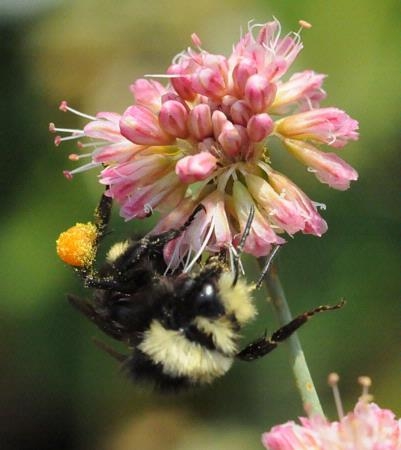
bumblebee on clover
Posted on
Friday, December 29, 2017 at
8:29 AM
| |
Adapted from
"The Remarkable Avocado Flower"
By Dr. B. O. Bergh
|
|
|
|
Introduction
The avocado (Persea americana Mill.) flower behavior is noteworthy in that there is nothing quite like it known in any other plant. The flower has both female and male organs, but they don't function at the same time. Each flower is female when it first opens. That is, its stigma will receive pollen from other avocado flowers, but its stamens (male organs) do not shed pollen at this first opening.
The petals and sepals, which look alike in the avocado, protect the delicate sex organs while they develop. The nectaries and staminodes secrete nectar that attracts bees. To obtain an avocado fruit, a bee (or other flying insect) must transfer pollen from a different flower to the stigma of this first-opening flower. Sperm from the pollen grow down under the slender style to fertilize the female egg inside the ovary, which then grows into the mature fruit. |
|
The unique avocado flower
The first or female stage remains open for only 2 or 3 hours. The flower then closes and remains closed the rest of the day and that night. The following day it opens again. But now the stigma will no longer receive pollen. Instead, the flower is now shedding pollen. That is, each flower is female at its first opening, male at its second. After being open several hours the second day, the flower closes again, this time for good. If it had been successfully pollinated at the first opening, and if other conditions are right, it will develop into a delicious fruit. |
|
|
|
|
 |
|
|
Click for large view
|
|
"A" and "B" type flowers
Nature has provided for avocado cross-pollination by creating varieties of two kinds. The "A" type is female in the morning of the first day and male in the afternoon of the second day (when the weather is warm). The "B" type is just the reverse: its flowers are female in the afternoon and male the following morning. For one flower of each variety, the timing will be as follows: |
|
| |
| |
First Day
|
Second Day
|
|
Flower Type
|
Morning
|
Afternoon
|
Morning
|
Afternoon
|
|
"A" Type
|
Female
|
|
|
Male
|
|
"B" Type
|
|
Female
|
Male
|
|
|
|
|
| But with hundreds of flowers opening in both stages day after day, the daily situation appears like this: |
|
| |
|
Flower Type
|
Morning
|
Afternoon
|
|
"A" Type
|
Female
|
Male
|
|
"B" Type
|
Male
|
Female
|
|
|
|
|
Flower opening and temperature
The two flowering types behave with clock-like exactness only when the average temperature (night minimum and day maximum) is above 70 degrees F (21.1 C). As temperatures fall, the daily openings become delayed and become irregular, so that a single tree may have flowers in both female and male stages at the same time. This helps to explain how large blocks of just one variety sometimes set heavy crops.
But, as the average temperature falls below about 70 F, the flower parts function less well. Below about 60 F (15.5 C), there may be zero set.
Check out Ken Melman's flower video
https://vimeo.com/7267944
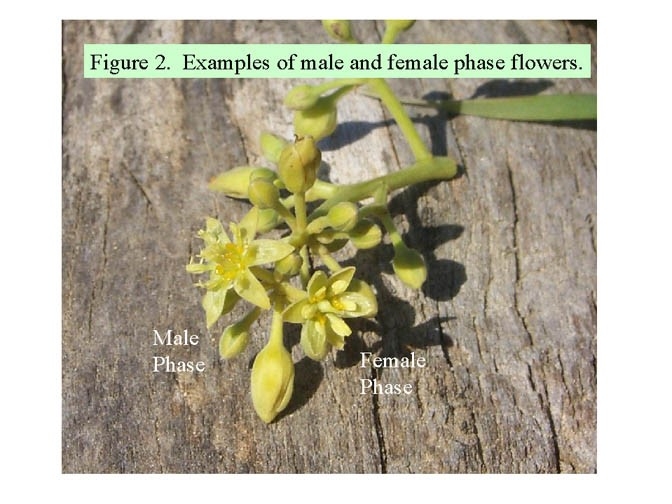
|
|
| |
|
|
|
|
|
|
|
|
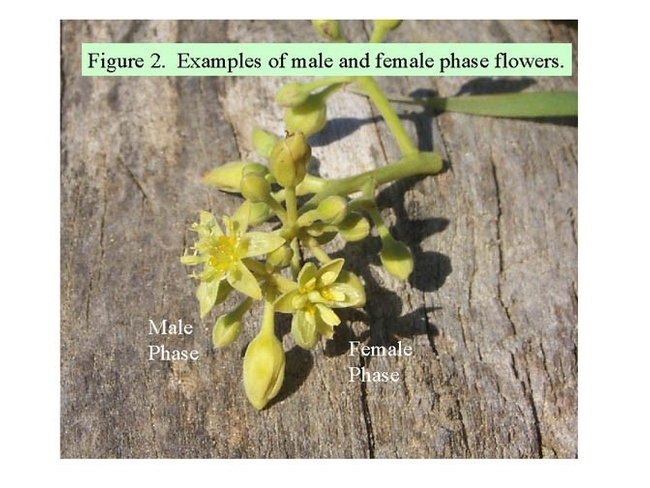
avocado flowers
Posted on
Thursday, April 13, 2017 at
12:55 PM
This article is from Florida Grower News. Thanks for Jim Lloyd-butler for pointing it out.
FLG-Editorial@MeisterMediaww.com
A sister species of the Varroa destructor mite is developing the ability to parasitize European honeybees, threatening pollinators already hard pressed by pesticides, nutritional deficiencies, and disease, a Purdue University study says.
Researchers found that some populations of Varroa jacobsoni mites are shifting from feeding and reproducing on Asian honeybees, their preferred host, to European honeybees, the primary species used for crop pollination and honey production worldwide. To bee researchers, it's a grimly familiar story: V. destructor made the same host leap at least 60 years ago, spreading rapidly to become the most important global health threat to European honeybees.
While host-switching V. jacobsoni mites have not been found outside of Papua New Guinea, Purdue researchers Gladys Andino and Greg Hunt say vigilance is needed to protect European honeybees worldwide from further risk.
“This could represent a real threat,” said Andino, a bioinformatics specialist with Information Technology at Purdue. “If this mite gets out of control and spreads, we might have another situation like V. destructor.”
Varroa mites are obligate parasites, meaning their lifecycle is inextricably entwined with that of their bee hosts. The mites can do serious damage to their hosts' health due to their relatively large size – “think of a tick as big as your fist,” Hunt said. Mites latch on to bees and feed on their hemolymph, insects' rough equivalent to blood, leaving behind open wounds that are susceptible to infection. They can also transmit diseases such as deformed wing virus and have been linked to colony collapse disorder.
To gain insight into the biology behind V. jacobsoni‘s host switch, Andino and Hunt, professor of behavioral genetics and honeybee specialist, studied the differences in gene expression between V. jacobsoni mites that fed and reproduced on Asian honeybees and those that parasitized European honeybees. Knowing which host cues mites respond to and the genes involved could lead to potential control strategies, the researchers said.
“If we can understand the mechanism, we might be able to disrupt, block, or manipulate that,” Andino said. “But first we have to understand what is happening and which genes are involved in allowing the mites to shift to a new host.”
Andino and Hunt said the mites' leap to European honeybees likely occurred within the last decade. Previously, V. jacobsoni mites were occasionally found on European honeybees but seemed unable to produce healthy offspring, limiting their destructive capacity.
Catching the host transition in its early stages will allow researchers to continue to investigate the complex genetic details behind the shift and monitor infected European honeybees, Hunt said.
“This happened once with one species of mite, and it looks like it's happening again. Maybe if we catch this as it's beginning, we'll be able to figure out why it's happening or, down the road, stop it.”
The paper was recently published in BMC Genomics.
Funding for the study and an ongoing genome-sequencing project was provided USDA's-Agricultural Research Service and the USDA National Institute of Food and Agriculture.
This article is from Florida Grower News
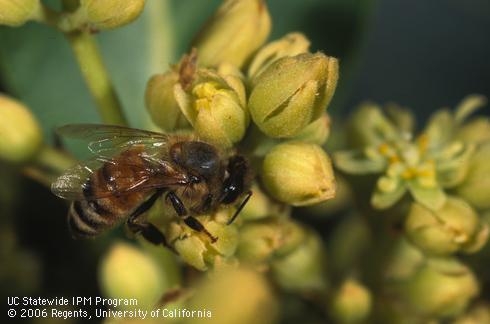
honey bee in avocado
Posted on
Tuesday, November 29, 2016 at
5:21 PM
- Author:
Christina Herrick



